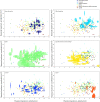Individual In-Situ GPS-Derived Acceleration-Speed Profiling: Toward Automatization and Refinement in Male Professional Rugby Union Players
- PMID: 38206549
- PMCID: PMC10784250
- DOI: 10.1186/s40798-023-00672-7
Individual In-Situ GPS-Derived Acceleration-Speed Profiling: Toward Automatization and Refinement in Male Professional Rugby Union Players
Abstract
Background: Recently a proof-of-concept was proposed to derive the soccer players' individual in-situ acceleration-speed (AS) profile from global positioning system (GPS) data collected over several sessions and games. The present study aimed to propose an automatized method of individual GPS-derived in-situ AS profiling in a professional rugby union setting.
Method: AS profiles of forty-nine male professional rugby union players representing 61.5 million positions, from which acceleration was derived from speed during 51 training sessions and 11 official games, were analyzed. A density-based clustering algorithm was applied to identify outlier points. Multiple AS linear relationships were modeled for each player and session, generating numerous theoretical maximal acceleration (A0), theoretical maximal running speed (S0) and AS slope (ASslope, i.e., overall orientation of the AS profile). Each average provides information on the most relevant value while the standard deviation denotes the method accuracy. In order to assess the reliability of the AS profile within the data collection period, data were compared over two 2-week phases by the inter-class correlation coefficient. A0 and S0 between positions and type of sessions (trainings and games) were compared using ANOVA and post hoc tests when the significant threshold had been reached.
Results: All AS individual profiles show linear trends with high coefficient of determination (r2 > 0.81). Good reliability (Inter-class Correlation Coefficient ranging from 0.92 to 0.72) was observed between AS profiles, when determined 2 weeks apart for each player. AS profiles depend on players' positions, types of training and games. Training and games data highlight that highest A0 are obtained during games, while greatest S0 are attained during speed sessions.
Conclusions: This study provides individual in-situ GPS-derived AS profiles with automatization capability. The method calculates an error of measurement for A0 and S0, of paramount importance in order to improve their daily use. The AS profile differences between training, games and playing positions open several perspectives for performance testing, training monitoring, injury prevention and return-to-sport sequences in professional rugby union, with possible transferability to other sprint-based sports.
Key points: AS profiles computed from rugby union GPS data provide positional benchmarks during training and competition. This study provides automatic detection of atypical data and the computation of error measurement of theoretical maximal acceleration and speed components. This refinement constitutes a step forward for a daily use of ecological data by considering data collection and method reliabilities. This easy-to-implement approach may facilitate its use to the performance management process (talent identification, training monitoring and individualization, return-to-sport).
Keywords: Rugby union; Running; Sprint; Testing.
© 2024. The Author(s).
Conflict of interest statement
The authors declare that the research was conducted in the absence of any commercial, financial or any other kind of interest that could be construed as a potential competing interests.
Figures




Similar articles
-
Individual acceleration-speed profile in-situ: A proof of concept in professional football players.J Biomech. 2021 Jun 23;123:110524. doi: 10.1016/j.jbiomech.2021.110524. Epub 2021 May 15. J Biomech. 2021. PMID: 34023754
-
Reliability of individual acceleration-speed profile in-situ in elite youth soccer players.J Biomech. 2023 May;153:111602. doi: 10.1016/j.jbiomech.2023.111602. Epub 2023 Apr 26. J Biomech. 2023. PMID: 37163953
-
Comparison of acceleration-speed profiles from training and competition to individual maximal sprint efforts.J Biomech. 2023 Aug;157:111724. doi: 10.1016/j.jbiomech.2023.111724. Epub 2023 Jul 11. J Biomech. 2023. PMID: 37451206
-
Quantifying Exposure and Intra-Individual Reliability of High-Speed and Sprint Running During Sided-Games Training in Soccer Players: A Systematic Review and Meta-analysis.Sports Med. 2023 Feb;53(2):371-413. doi: 10.1007/s40279-022-01773-1. Epub 2022 Nov 4. Sports Med. 2023. PMID: 36331702 Free PMC article.
-
Optimising Sprint Performance in Rugby: Insights from a Systematic Review of Training Methods.J Funct Morphol Kinesiol. 2025 Jan 29;10(1):51. doi: 10.3390/jfmk10010051. J Funct Morphol Kinesiol. 2025. PMID: 39982291 Free PMC article. Review.
Cited by
-
Agreement and Sensitivity of the Acceleration-Velocity Profile Derived via Local Positioning System.Sensors (Basel). 2024 Sep 25;24(19):6192. doi: 10.3390/s24196192. Sensors (Basel). 2024. PMID: 39409234 Free PMC article.
References
-
- Fornasier-Santos C, Millet GP, Stridgeon P, Brocherie F, Girard O, Nottin S. How does playing position affect fatigue-induced changes in high-intensity locomotor and micro-movements patterns during professional rugby union games? Eur J Sport Sci. 2021;21:1364–1374. doi: 10.1080/17461391.2020.1829715. - DOI - PubMed
LinkOut - more resources
Full Text Sources
Research Materials

